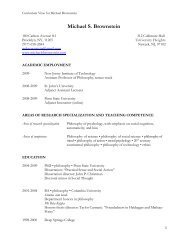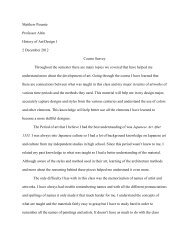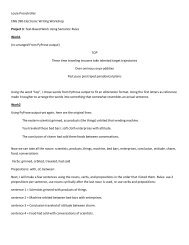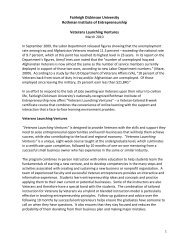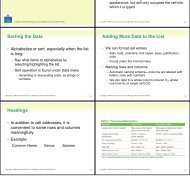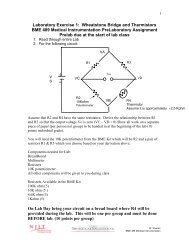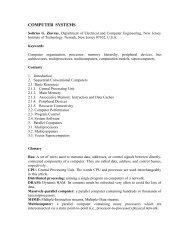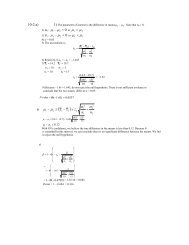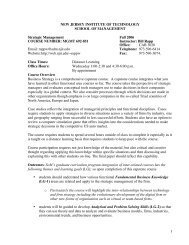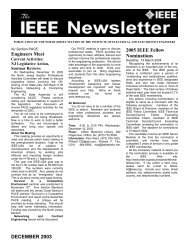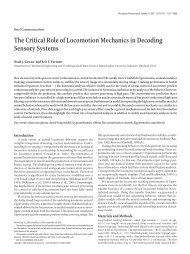The Pizza Company Inventory Tracking Database - Njit.edu
The Pizza Company Inventory Tracking Database - Njit.edu
The Pizza Company Inventory Tracking Database - Njit.edu
You also want an ePaper? Increase the reach of your titles
YUMPU automatically turns print PDFs into web optimized ePapers that Google loves.
<strong>The</strong> <strong>Pizza</strong> <strong>Company</strong><br />
<strong>Inventory</strong> <strong>Tracking</strong> <strong>Database</strong><br />
Jim Lubey<br />
Debbie Miksiewicz<br />
DBM380<br />
April 17, 2011
Table of Contents<br />
Abstract 3<br />
Business Rules 4<br />
Elements of the <strong>Database</strong> 5<br />
Tables / Entities 5<br />
Attributes / Properties 5<br />
Identifiers 5<br />
Relationships 6<br />
Cardinality 6<br />
Entity-Relationship (E-R) Diagram 7<br />
Schema 8<br />
Delivery_Method Table 8<br />
Employee Table 9<br />
Ingredient Table 10<br />
Ingredient_Category Table 11<br />
<strong>Inventory</strong>_Transaction Table 12<br />
Orders Table 13<br />
Suppliers Table 14<br />
Business Functions 15<br />
Forms – General 15<br />
Forms – Columns / Display Names 17<br />
Reports 20<br />
Summary 21<br />
References 22<br />
<strong>The</strong> <strong>Pizza</strong> <strong>Company</strong> <strong>Inventory</strong> <strong>Tracking</strong> <strong>Database</strong> 2
Abstract<br />
<strong>The</strong> <strong>Pizza</strong> <strong>Company</strong> <strong>Inventory</strong> <strong>Tracking</strong> <strong>Database</strong> 3<br />
<strong>The</strong> <strong>Pizza</strong> <strong>Company</strong> is a fictitious company chosen by the members of Team A to illustrate the development of an inventory system. In the<br />
following diagrams, we will show the details of the inventory system as it applies to the various functional areas involved in the materials<br />
management of the inventory of this pizza company. Covered in this paper are the business rules, the data base elements, and the requirements. We<br />
will also discuss the schema and the entity relationship diagram that such a database would require, in addition to typical user reports.
Business Rules<br />
<strong>The</strong> <strong>Pizza</strong> <strong>Company</strong> <strong>Inventory</strong> <strong>Tracking</strong> <strong>Database</strong> 4<br />
As with any database, determining business rules was an important part of our design process. Users have specific requirements, which the<br />
database must meet. During the data modeling stage, we attempted to determine what these rules are, and to adjust the database relations<br />
accordingly. Understanding the business processes, and knowing how the business has decided to use the database information are critical.<br />
<strong>The</strong> <strong>Pizza</strong> <strong>Company</strong> makes frozen pizzas and distributes them to supermarkets and grocery stores for sale to the public. In the tables and<br />
relationships shown in this documentation, we show how each process step is dependent upon or related to the database model. <strong>The</strong> <strong>Pizza</strong><br />
<strong>Company</strong> employs several associates who have the authority to order (add to inventory) ingredients and to remove items from inventory to use in<br />
the production of the pizza. <strong>The</strong>se specially trained production control staff have an in-depth understanding of the company processes.<br />
Generally, the <strong>Pizza</strong> <strong>Company</strong> buys ingredients, and the supplier delivers them. Occasionally the <strong>Pizza</strong> <strong>Company</strong> picks up a purchase in the<br />
corporate vehicle. <strong>The</strong> company considers orders as changes to the ‘Ingredient warehouse’ indicating a ‘Purchased’ or ‘Used in Production’. Every<br />
Order must have certain information, including the employee’s name that entered the order, and the Ingredient supplier’s name. <strong>The</strong> general<br />
business rules are as follows:<br />
• <strong>The</strong> company buys ingredients from several suppliers.<br />
• Perishable ingredients have a percentage of shrinkage.<br />
• <strong>The</strong> unit of measure for all of the Ingredients is the pound.<br />
• <strong>The</strong> Ingredient_Name contains units of measure for bulk items used for packaging. (i.e.: “500 foot role of Z-wrap – 24 inches wide”)<br />
• <strong>The</strong>re are five categories of Ingredients. <strong>The</strong>se are the crust, the toppings, the cheese, the sauce, and packaging.<br />
• <strong>The</strong> <strong>Pizza</strong> <strong>Company</strong> employees have the authority to order or remove items from inventory.<br />
• All required database fields must be complete to create an order.
Elements of the <strong>Database</strong><br />
Tables / Entities<br />
Entities are items that the user wants to track. An entity class is a group of entities of the same type. We use seven tables:<br />
� Delivery_Methods<br />
� Employees<br />
� Ingredients<br />
� Ingredient_Categories<br />
� <strong>Inventory</strong>_Transactions<br />
� Orders<br />
� Suppliers<br />
Attributes / Properties<br />
<strong>The</strong> <strong>Pizza</strong> <strong>Company</strong> <strong>Inventory</strong> <strong>Tracking</strong> <strong>Database</strong> 5<br />
Attributes (also called properties) describe the characteristics of the entity, thus giving it definition. <strong>The</strong> table properties include the physical<br />
name and conceptual name (which in this case are the same), columns, primary key, and indexes. Properties for columns include the physical<br />
name, display name, data type and length, and whether or not it is a primary key and or required. <strong>The</strong> attributes of our ingredients are self-<br />
describing, and therefore make ordering easier to understand.<br />
Identifiers<br />
Identifiers are those attributes that identify the entity instances (instances are representations of a specific entity.)
Relationships<br />
<strong>The</strong> <strong>Pizza</strong> <strong>Company</strong> <strong>Inventory</strong> <strong>Tracking</strong> <strong>Database</strong> 6<br />
Relationships describe how entities are associated with each other. <strong>The</strong>re are three types of relationships, one to one, one to many, and many to<br />
many. <strong>The</strong>se relationships define how entity instances relate. Relationships also provide us with critical information about entity interactions.<br />
In this project, there are six relationships. <strong>The</strong>re is a relation of one to many between Ingredients and Ingredient_Categories. <strong>The</strong> relationship<br />
between Orders and Delivery_Method and Orders and Employees are each one to one. <strong>The</strong> relationship between Orders and Suppliers is one to<br />
many because sometimes a request for ingredients from manufacturing contains items from one or more suppliers. Orders to Suppliers (items<br />
purchased) are always one order submitted to one supplier. <strong>The</strong> <strong>Inventory</strong>_Transaction table has a many to one relation to Ingredients and also a<br />
many to one relation to Orders. <strong>The</strong> five relationship names are:<br />
� Delivery_Method_Orders<br />
� Ingredient_Ingredient_Category<br />
� <strong>Inventory</strong>_Transaction_Ingredients<br />
� <strong>Inventory</strong>_Transaction_Orders<br />
� Orders_Employees<br />
� Orders_Suppliers<br />
Cardinality<br />
In general, each relationship can also have a minimum and maximum cardinality associated with it to show which relationships are optional,<br />
which are mandatory, and any numerical limitations on these relationships. <strong>The</strong> cardinality for this database is:<br />
� Delivery_Method_Orders is 1:1<br />
� Ingredient_Ingredient_Category is 1:1<br />
� <strong>Inventory</strong>_Transaction_Ingredients is 1:1<br />
� <strong>Inventory</strong>_Transaction_Orders: 1:N<br />
� Orders_Employees: is N:1<br />
� Orders_Suppliers is 1:1
Entity-Relationship (E-R) Diagram<br />
<strong>The</strong> <strong>Pizza</strong> <strong>Company</strong> <strong>Inventory</strong> <strong>Tracking</strong> <strong>Database</strong> 7<br />
To document the <strong>Pizza</strong> <strong>Company</strong> database, we used the following Entity-Relationship (E-R) diagrams. <strong>The</strong> following diagram graphically<br />
depicts the various relationships, the associated cardinality, and the entity classes of the relationship.<br />
<strong>Inventory</strong>_Transactions<br />
PK <strong>Inventory</strong>_Transaction_ID<br />
I1 <strong>Inventory</strong>_Transaction_Date<br />
FK3,I2 Ingredient_ID<br />
FK4 Order_ID<br />
<strong>Inventory</strong>_Transaction_Description<br />
Unit_Price<br />
Units_Ordered<br />
Units_Received<br />
Units_Sold<br />
Units_Shrinkage<br />
Ingredients<br />
PK Ingredient_ID<br />
I1 Ingredient_Name<br />
Ingredient_Description<br />
FK2,I2 Ingredient_Category_ID<br />
Unit_Price<br />
Unit_Size<br />
Reorder_Level<br />
Discontinued<br />
Lead_Time<br />
<strong>The</strong> <strong>Pizza</strong> <strong>Company</strong> <strong>Inventory</strong> <strong>Tracking</strong> ERD<br />
PK Order_ID<br />
Orders<br />
Order_Number<br />
Order_Description<br />
FK9,I1 Supplier_ID<br />
FK6,I4 Employee_ID<br />
I3 Order_Date_Time<br />
Promised_Ready_Date_Time<br />
Delivery_Date_Time<br />
FK4 Delivery_ID<br />
Delivery_Charge<br />
Ingredient_Categories<br />
PK Ingredient_Category_ID<br />
I1 Ingredient_Category_Name<br />
Suppliers<br />
PK Supplier_ID<br />
I2 Supplier_Name<br />
Contact_Name<br />
Contact_Title<br />
Address<br />
City<br />
State<br />
I3 Zip_Code<br />
Phone<br />
FAX<br />
Payment_Terms<br />
Remarks<br />
Delivery_Methods<br />
PK Delivery_ID<br />
Delivery_Method<br />
Employees<br />
PK Employee_ID<br />
First_Name<br />
I1 Last_Name<br />
Title<br />
Work_Phone<br />
Extension
Schema<br />
<strong>The</strong> <strong>Pizza</strong> <strong>Company</strong> <strong>Inventory</strong> <strong>Tracking</strong> <strong>Database</strong> 8<br />
<strong>The</strong> following schema defines aspects of the database, such as attributes (fields), domains, and parameters of the <strong>Pizza</strong> <strong>Company</strong> database. As<br />
shown here, each table has specific definitions that apply to each item, and enforce some of the business rules.<br />
Delivery_Method Table<br />
Table Column Keys<br />
Delivery_Methods<br />
Data<br />
Type<br />
Delivery _ID PK Integer 10<br />
Delivery<br />
_Method<br />
max Note<br />
Auto<br />
Counter<br />
User<br />
Input:<br />
Data field<br />
req<br />
during a<br />
trans.<br />
VarChar 10 X<br />
DBM<br />
Input:<br />
Data<br />
fields<br />
input<br />
prior to a<br />
trans.<br />
Data<br />
defaults<br />
Permitted Value,<br />
range of values,<br />
or formula<br />
X 0-9999999999 Autocounter<br />
air; ground,<br />
refrigerated truck,<br />
will call<br />
Comment<br />
User Input - User may decide how we want it<br />
shipped, when placing the order
Employee Table<br />
Table Column Keys<br />
Employee<br />
Data<br />
Type<br />
Employee _ID PK Integer 10<br />
max Note<br />
Auto<br />
Counter<br />
User<br />
Input:<br />
Data field<br />
req<br />
during a<br />
trans.<br />
DBM<br />
Input:<br />
Data<br />
fields<br />
input<br />
prior to a<br />
trans.<br />
Data<br />
defaults<br />
<strong>The</strong> <strong>Pizza</strong> <strong>Company</strong> <strong>Inventory</strong> <strong>Tracking</strong> <strong>Database</strong> 9<br />
Permitted Value,<br />
range of values,<br />
or formula<br />
X X 0-999999999<br />
First _Name VarChar 30 X REQUIRED<br />
Last _Name I1 VarChar 30 X REQUIRED<br />
Title VarChar 50 X<br />
Work _Phone VarChar 30 X REQUIRED<br />
Extension VarChar 10 X<br />
Comment<br />
This would be a choice during transactions (auto<br />
generated when record is created). An Employee<br />
Form by user creates dropdown list for<br />
Transaction (Use Ingredient or Order Ingredient)<br />
This would be filled in by system during a<br />
transaction, based on Employee _ID (user input<br />
when employee record is created or edited)<br />
This would be filled in by system during a<br />
transaction, based on Employee _ID (user input<br />
when employee record is created or edited)<br />
This would be filled in by system during a<br />
transaction, based on Employee_ID (user input<br />
when employee record is created or edited)<br />
This would be filled in by system during a<br />
transaction, based on Employee_ID (user input<br />
when employee record is created or edited)<br />
This would be filled in by system during a<br />
transaction, based on Employee _ID (user input<br />
when employee record is created or edited)
Ingredient Table<br />
Table Column Keys<br />
Ingredients<br />
Data<br />
Type<br />
Ingredient _ID PK Integer 10<br />
Ingredient<br />
_Name<br />
Ingredients<br />
_Description<br />
Ingredient<br />
_Category _ID<br />
max Note<br />
Auto<br />
Counter<br />
User<br />
Input:<br />
Data field<br />
req<br />
during a<br />
trans.<br />
DBM<br />
Input:<br />
Data<br />
fie lds<br />
input<br />
prior to a<br />
trans.<br />
Data<br />
defaults<br />
Permitted Value,<br />
range of values,<br />
or formula<br />
X X 0-999999999<br />
I1 VarChar 50 X X<br />
VarChar 50 X X<br />
FK, I2 Integer 10 X<br />
<strong>The</strong> <strong>Pizza</strong> <strong>Company</strong> <strong>Inventory</strong> <strong>Tracking</strong> <strong>Database</strong> 10<br />
Comment<br />
This would be a choice during transactions (auto<br />
generated when record is created)<br />
Ground beef,<br />
Mushrooms, olives, This would be filled in by system during a<br />
ham. Pineapple. transaction, based on Ingredient_ID (user input<br />
Sausage. Green when Ingredient record is created or edited)<br />
peppers, pepperoni<br />
i.e.: for ground<br />
beef the<br />
description would<br />
be "Lean Ground<br />
Beef"<br />
This would be filled in by system during a<br />
transaction, based on Ingredient_ID (user input<br />
when Ingredient record is created or edited)<br />
See<br />
Ingredient_Catego User selects Ingredient category from list<br />
ry_ID in Ingredient (Ingredient form<br />
Category Table<br />
Unit _Price Currency 10 X<br />
Cost at time of last<br />
User enters in Ingredient form<br />
purchase<br />
Unit _Size VarChar 20 X<br />
pound, each,<br />
bushel etc…<br />
depending on<br />
supplier, and<br />
User enters in Ingredient form<br />
ReOrder _Level Integer 10 X<br />
perishable, this is<br />
User enters in Ingredient form<br />
the number of day<br />
it takes to reorder<br />
and receive<br />
This field indicates that the ingredient is no longer<br />
Discontinued Boolean 2 X Yes - No<br />
used at our company. Yes would make the item<br />
not show up in any new dropdowns of ingredients.<br />
User inputs this value.<br />
Lead _Time VarChar 30 X<br />
User enters in Ingredient form the date provided<br />
by the seller
Ingredient_Category Table<br />
Table Column Keys<br />
Ingredient _Categories<br />
Ingredient<br />
_Category _ID<br />
Ingredient<br />
_Category<br />
_Name<br />
Data<br />
Type<br />
PK Integer 10<br />
max Note<br />
Auto<br />
Counter<br />
User<br />
Input:<br />
Data field<br />
req<br />
during a<br />
trans.<br />
DBM<br />
Input:<br />
Data<br />
fields<br />
input<br />
prior to a<br />
trans.<br />
I1 VarChar 20 X<br />
Data<br />
defaults<br />
<strong>The</strong> <strong>Pizza</strong> <strong>Company</strong> <strong>Inventory</strong> <strong>Tracking</strong> <strong>Database</strong> 11<br />
Permitted Value,<br />
range of values,<br />
or formula<br />
X 0-999999999 System<br />
Initially these are:<br />
Topping, Cheese,<br />
Sauce Crust…<br />
Comment<br />
Form to add/edit/delete Ingredient Categories<br />
Used for Order or purchases
<strong>Inventory</strong>_Transaction Table<br />
Table Column Keys<br />
<strong>Inventory</strong>_Transactions<br />
<strong>Inventory</strong><br />
_Transaction<br />
_ID<br />
<strong>Inventory</strong><br />
_Transaction<br />
_Date<br />
Data<br />
Type<br />
PK Integer 10<br />
max Note<br />
Auto<br />
Counter<br />
User<br />
Input:<br />
Data field<br />
req<br />
during a<br />
trans.<br />
I1 Date/Time 15 X<br />
DBM<br />
Input:<br />
Data<br />
fields<br />
input<br />
prior to a<br />
trans.<br />
Data<br />
defaults<br />
<strong>The</strong> <strong>Pizza</strong> <strong>Company</strong> <strong>Inventory</strong> <strong>Tracking</strong> <strong>Database</strong> 12<br />
Permitted Value,<br />
range of values,<br />
or formula<br />
X 0-999999999 System<br />
short date format<br />
(I.e.: 01/01/1901)<br />
Default is (today)<br />
Comment<br />
Ingredient _ID FK3 Integer 10 X<br />
See<br />
Ingredient_Catego<br />
User selects Ingredient from list (<strong>Inventory</strong> Form)<br />
ry_ID in Ingredient<br />
Table<br />
Order _ID<br />
<strong>Inventory</strong><br />
FK4 Integer 10 X<br />
See Order_ID in<br />
Ingredient Table<br />
Generated from order<br />
_Transaction<br />
_Description<br />
VarChar 50 X Purchased; WIP user input<br />
Unit _Price Currency 10 X from Ingredient table<br />
Units _Ordered Integer 10 X from purchase or sale record<br />
Units _Received Integer 10 X from purchase or sale record<br />
Units _Sold Integer 10 X From Order table<br />
Units<br />
_Shrinkage<br />
Integer 10 X<br />
= (Units_Ordered -<br />
User Input<br />
Units_Received)
Orders Table<br />
Table Column Keys<br />
Data<br />
Type<br />
max Note<br />
User<br />
Input:<br />
Data field<br />
req<br />
during a<br />
trans.<br />
DBM<br />
Input:<br />
Data<br />
fields<br />
input<br />
prior to a<br />
trans.<br />
Data<br />
defaults<br />
<strong>The</strong> <strong>Pizza</strong> <strong>Company</strong> <strong>Inventory</strong> <strong>Tracking</strong> <strong>Database</strong> 13<br />
Permitted Value,<br />
range of values,<br />
or formula<br />
Comment<br />
Orders<br />
Order _ID PK Integer 10<br />
Auto<br />
Counter<br />
X 0-999999999<br />
This would be a choice during transactions (auto<br />
generated when record is created)<br />
Order _Number VarChar 30 X User Input<br />
Order<br />
_Description<br />
VarChar 255 X User Input<br />
Supplier _ID FK9, I1 Integer 10 X<br />
User Chooses from list created from Supplier<br />
Form<br />
Employee _ID FK6, I4 Integer 10 X<br />
User Chooses from list created from Employee<br />
Form<br />
Order _Date<br />
_Time<br />
Date/Time 15 X<br />
long date format<br />
(I.e.: 01/01/1901<br />
5:00 PM)<br />
User Input<br />
Promised<br />
long date format<br />
_Ready _Date Date/Time 15 X<br />
(I.e.: 01/01/1901 User Input<br />
_Time<br />
5:00 PM)<br />
Deliver _Date<br />
_Time<br />
Date/Time 15 X<br />
long date format<br />
(I.e.: 01/01/1901<br />
5:00 PM)<br />
User Input<br />
Delivery _ID FK4 Integer 10 X<br />
User Chooses from list created from Delivery<br />
Type Form<br />
Delivery<br />
_Charge<br />
Currency 10 X X<br />
depends on<br />
delivery method<br />
When a delivery method is selected, related charge<br />
will be displayed
Suppliers Table<br />
Table Column Keys<br />
Data<br />
Type<br />
max Note<br />
User<br />
Input:<br />
Data field<br />
req<br />
during a<br />
trans.<br />
DBM<br />
Input:<br />
Data<br />
fields<br />
input<br />
prior to a<br />
trans.<br />
Data<br />
defaults<br />
Permitted Value,<br />
range of values,<br />
or formula<br />
<strong>The</strong> <strong>Pizza</strong> <strong>Company</strong> <strong>Inventory</strong> <strong>Tracking</strong> <strong>Database</strong> 14<br />
Comment<br />
Suppliers<br />
Supplier _ID PK Integer 10<br />
Auto<br />
Counter<br />
X 0-999999999<br />
This would be a choice during transactions (auto<br />
generated when record is created)<br />
This would be filled in by system during a<br />
Supplier _Name I2 VarChar 50 X REQUIRED transaction, based on Supplier_ID (user input<br />
when Supplier record is created or edited)<br />
This would be filled in by system during a<br />
Contact _Name VarChar 50 X REQUIRED transaction, based on Supplier_ID (user input<br />
when Supplier record is created or edited)<br />
This would be filled in by system during a<br />
Contact _Title VarChar 50 X X<br />
transaction, based on Supplier_ID (user input<br />
when Supplier record is created or edited)<br />
This would be filled in by system during a<br />
Address VarChar 255 X REQUIRED transaction, based on Supplier_ID (user input<br />
when Supplier record is created or edited)<br />
This would be filled in by system during a<br />
City VarChar 50 X REQUIRED transaction, based on Supplier_ID (user input<br />
when Supplier record is created or edited)<br />
This would be filled in by system during a<br />
State VarChar 20 X REQUIRED transaction, based on Supplier_ID (user input<br />
when Supplier record is created or edited)<br />
This would be filled in by system during a<br />
Zip _Code I3 VarChar 20 X REQUIRED transaction, based on Supplier_ID (user input<br />
when Supplier record is created or edited)<br />
This would be filled in by system during a<br />
Phone VarChar 30 X X REQUIRED transaction, based on Supplier_ID (user input<br />
when Supplier record is created or edited)<br />
This would be filled in by system during a<br />
FAX VarChar 30 X X<br />
transaction, based on Supplier_ID (user input<br />
when Supplier record is created or edited)<br />
Payment<br />
_Terms<br />
VarChar 255 X X REQUIRED<br />
This would be filled in by system during a<br />
transaction, based on Supplier_ID (user input<br />
when Supplier record is created or edited)<br />
Remarks VarChar 255 X User Input
Business Functions<br />
Forms – General<br />
<strong>The</strong> <strong>Pizza</strong> <strong>Company</strong> <strong>Inventory</strong> <strong>Tracking</strong> <strong>Database</strong> 15<br />
<strong>The</strong>re will be six forms and two child forms used to add, edit or delete records. <strong>The</strong> parent forms are the Employee Form, the Supplier Form,<br />
the Delivery Method Form, the Ingredient Form, and the Ingredient Category Form. <strong>The</strong> Child forms are the Purchase Order sub form, and the<br />
Ingredient sub form.<br />
<strong>The</strong> Purchase Order sub form is contained on the Orders Form. <strong>The</strong> Ingredient sub form is found on the Ingredients form.<br />
<strong>The</strong> purpose of the Purchase Order Form is to create a printable request for ingredients, that can be faxed or mailed to a supplier, while the<br />
Ingredients sub form is used to maintain a record of transactions affecting an particular ingredient.<br />
Before using the system to keep track of inventory, someone must enter employees, suppliers, ingredient categories and Delivery methods.<br />
Note: Employees with the appropriate permission can add new employees, suppliers, ingredients categories, and delivery methods as needed while<br />
creating an order.<br />
<strong>The</strong> Employee Form, the Supplier Form, <strong>The</strong> Delivery Method Form and the Ingredient Category Form are simple forms to record data used<br />
for the more complex Ingredient from, queries and reports.<br />
<strong>The</strong>se initial records will be used to choose from, when a user creates orders and other inventory transactions.<br />
Employees use the Ingredient Form to initially describe the particular ingredient and later to record transaction, using the sub form to record items<br />
that remove items from inventory. <strong>The</strong>re are two calculated fields on the form displaying current on hand and on-order quantities.
<strong>The</strong> <strong>Pizza</strong> <strong>Company</strong> <strong>Inventory</strong> <strong>Tracking</strong> <strong>Database</strong> 16<br />
A user would use the Order form to add Ingredient quantities to the inventory. After creating an order, the user will have the option to create a<br />
printable purchase order to send to a supplier. Order transaction, which add to the inventory and transactions that subtract from inventory (entered<br />
directly into the Ingredient sub form) are all maintained in the <strong>Inventory</strong>_Transaction table, and are displayed in the Ingredient sub form.<br />
Ingredients sub form depicted as a table on the Ingredient parent form.<br />
Date Order ID Ingredient Description # Ordered # Received<br />
7/20/2002 102 Tomatoes<br />
# Used<br />
in MFG # Shrinkage<br />
Purchase from Albino’s<br />
Produce Co. 10 0 1 2<br />
7/23/2002 102 Tomatoes<br />
Received from Albino’s<br />
Produce Co. 0 10 0 0<br />
7/24/2002 Tomatoes Sent to MFG 0 0 5 0<br />
7/24/2002 Tomatoes Removed spoiled items 0 0 0 0.5<br />
Purchase Order sub form for order # 102 depicted as a table on the Orders parent form.<br />
Date Ingredient # Ordered Unit Price Line Total<br />
7/20/2002 Tomatoes 10 $12.50 $ 125.00<br />
7/20/2002 Green Peppers 2 $23.00 $46.00<br />
7/20/2002 Mushrooms 4 $32.00 $128.00
Forms – Columns / Display Names<br />
<strong>The</strong> following table describes the display names and row sources for each form and sub forms used in the system.<br />
Form Name Source Column Display<br />
Name<br />
Categories Form Ingredient_Categories Ingredient_Category_ID Category ID<br />
Ingredient_Category_Name Category<br />
Name<br />
Delivery Methods Delivery_Methods Delivery_Method_ID Delivery<br />
Form<br />
Method ID<br />
Delivery_Method Delivery<br />
method<br />
Employees Form Employees Employee_ID Employee ID<br />
First_Name First Name<br />
Last_Name Last Name<br />
Title Title<br />
Work_Phone Phone<br />
Extension Extension<br />
Ingredients Form Ingredients Ingredient_ID Ingredient ID<br />
Ingredient_Name Ingredient<br />
Name<br />
Ingredient_ Description Ingredient<br />
Description<br />
Ingredient_Category_ID Category<br />
Unit_Price Unit Price<br />
Reorder_Level Reorder<br />
Level<br />
Discontinued Discontinued<br />
Lead_Time Lead Time<br />
Units On<br />
Hand<br />
Units on<br />
Order<br />
Ingredient<br />
List<br />
Ingredient<br />
Subform<br />
Ingredients Order_Date Date<br />
<strong>The</strong> <strong>Pizza</strong> <strong>Company</strong> <strong>Inventory</strong> <strong>Tracking</strong> <strong>Database</strong> 17<br />
Notes<br />
Units_received - Units_Sold -<br />
Units_Shrinkage<br />
Units_Ordered - Units_Received<br />
See Ingredient Sub form
<strong>The</strong> <strong>Pizza</strong> <strong>Company</strong> <strong>Inventory</strong> <strong>Tracking</strong> <strong>Database</strong> 18<br />
Form Name Source Column Display<br />
Name<br />
Notes<br />
Ingredients Ingredient Ingredient<br />
<strong>Inventory</strong>_Transactions Units_Ordered Units<br />
Ordered<br />
Ingredients Unit_Price Unit Price<br />
Line Total Units_Ordered * Unit_Price<br />
Order Form Orders Order_ID Order ID<br />
Order_Number Order<br />
Number<br />
Order_Description Description<br />
Supplier_ID Supplier SELECT DISTINCTROW Suppliers.*<br />
FROM Suppliers ORDER BY<br />
[Suppliers].[Supplier_Name];<br />
Employee_ID Employee SELECT [Employee_ID],<br />
[Last_Name] & ", " & [First_Name]<br />
FROM Employees ORDER BY<br />
[Last_Name] & ", " & [First_Name];<br />
Order_Date_Time Order Date<br />
Date_Required Date<br />
Required<br />
Promised_Ready_Date_Time Date<br />
Promised<br />
Ship_Date Ship Date<br />
Delivery_Method_ID Delivery SELECT DISTINCTROW<br />
Method [Delivery_Methods]. * FROM<br />
[Delivery_ Methods] ORDER BY<br />
[Delivery_Methods].Delivery_Method;<br />
Delivery_Charge Delivery<br />
Charge<br />
<strong>Inventory</strong><br />
Order List<br />
See Purchase Order Sub form<br />
Purchase Order<br />
(Subform)<br />
<strong>Inventory</strong>_Transactions TransactionDate_Date Date<br />
Ingredient Ingredient_ID Ingredient SELECT DISTINCTROW Ingredients.<br />
* FROM Ingredients ORDER BY<br />
[Ingredients].[Ingredient_Name];<br />
<strong>Inventory</strong>_Transactions Units_Ordered Units Orderd<br />
<strong>Inventory</strong>_Transactions Unit_Price Unit Price
<strong>The</strong> <strong>Pizza</strong> <strong>Company</strong> <strong>Inventory</strong> <strong>Tracking</strong> <strong>Database</strong> 19<br />
Form Name Source Column Display<br />
Name<br />
Notes<br />
Line Total Unit_Price * Units_Ordered<br />
Suppliers Form Suppliers Supplier_ID Supplier ID Hidden<br />
Supplier_Name Supplier<br />
Name<br />
Contact_Name Contact<br />
Name<br />
Contact_Title Contact Title<br />
Address Address<br />
City City<br />
State State<br />
Zip_Code Zip Code<br />
Phone Phone<br />
Number<br />
FAX Fax Number<br />
Payment_Terms Payment<br />
Terms<br />
Remarks Remarks
<strong>The</strong> five Reports that <strong>The</strong> <strong>Pizza</strong> <strong>Company</strong> initially requires are:<br />
Reports<br />
<strong>The</strong> Ingredient Cost Comparison Report (by date and supplier) generated from a Select Statement that will result in a report showing the<br />
Ingredient_Name, Supplier_Name, Average Unit_Price, Total Units, and summaries. Employees use this report to determine the best average price<br />
that a supplier offers, for a particular ingredient.<br />
<strong>The</strong> Ingredients Purchased Report (by date and supplier name) generated from a Select Statement and will display the Ingredient_Name, <strong>The</strong><br />
Supplier_Name, <strong>The</strong> Average Unit_Price, the Total_Units and summaries. This report will summarize ingredients purchased from various<br />
suppliers.<br />
<strong>The</strong> <strong>Inventory</strong> Summary Report generated from a Select Statement shows quantities coming in and going out of stock. <strong>The</strong> fields that will be<br />
included are: Ingredient_Name, Reorder_Level, Lead _Time, Number In Stock, and Number on Order. This report will be viewed/printed daily to<br />
determine what if anything should be ordered.<br />
<strong>The</strong> Ingredient Transaction Detail Report (sorted by date) generated from a Select Statement shows the history of all ingredients. <strong>The</strong> fields<br />
included are Ingredient_Name, Transaction_Date, transaction_Description, Unit_Price, Units_Ordered, Units_Received, Units_Sold, and<br />
Units_Shrinkage.<br />
<strong>The</strong> Purchase Order is the hard copy of an order to be sent to a supplier. It is generated from a Select Statement and contains the Employee’s<br />
First_Name, Last_Name, Order_Date, Order_ID, Order_Number, Date_Required, Date_Promised, Delivery_Method, Order_Description. <strong>The</strong><br />
supplier portion will include Supplier_Name, Contact_Name, Address, City, State, Phone, and Fax. <strong>The</strong> Ingredient portion of the document will<br />
include the Ingredient_ID, Ingredient_Name, Units_Ordered, Unite_Price, and a line subtotal. <strong>The</strong>re will also be a grand total displayed.
Summary<br />
<strong>The</strong> <strong>Pizza</strong> <strong>Company</strong> <strong>Inventory</strong> <strong>Tracking</strong> <strong>Database</strong> 21<br />
<strong>The</strong> <strong>Pizza</strong> <strong>Company</strong> is a fictitious company chosen by the members of Team A to illustrate the development of an inventory system. In the<br />
preceding pages, we demonstrated the step-by-step requirements needed to develop a productive database that would satisfy the requirements of<br />
this particular company. We have shown the details of the inventory system as it applies to the various functional areas involved in the materials<br />
management of the inventory, and how the ordering process is controlled. <strong>The</strong> comprehensive set of business rules was created to set the database<br />
criteria so those business requirements were met. Finally, documentation of the schema and entity-relationships serves as a visual guide that shows<br />
the user how the database fields relate to one another, in addition to providing a clear map for report generation.<br />
Developing a database is a complex process, requiring that both the potential users and the database developer work together to create one<br />
vision of the completed product. While every design may require some adjustments once in actual implementation, using the tools we have shown<br />
here will go a long way towards creating a near perfect product. Documentation is critical, not only in the design phase, but for future<br />
programmers who may need to maintain this database in the future. At the <strong>Pizza</strong> <strong>Company</strong>, Team A has provided such documentation.
References<br />
<strong>The</strong> <strong>Pizza</strong> <strong>Company</strong> <strong>Inventory</strong> <strong>Tracking</strong> <strong>Database</strong> 22<br />
Kroenke, D. M. (2000). <strong>Database</strong> Processing: Fundamentals, Design and Implementation: Sections 1-6 (University of Phoenix Custom Edition).<br />
Needham Heights, MA: Pearson Custom Publishing.<br />
Kroenke, D. M. (2002). <strong>Database</strong> Processing: Fundamentals, Design and Implementation: 8 th edition. Upper Saddle River, NJ: Pearson<br />
Education.


